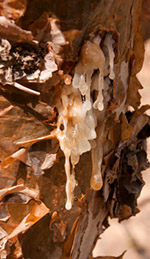 The well-known story of the three Magi bringing gifts to the newborn baby in Bethlehem is a cherished vision, but the value of those gifts is often underrated by those who don’t understand how priceless these essences were to people living in those regions of the world during the first century.
The well-known story of the three Magi bringing gifts to the newborn baby in Bethlehem is a cherished vision, but the value of those gifts is often underrated by those who don’t understand how priceless these essences were to people living in those regions of the world during the first century.
Ancient medical documents dating back to 1500 B.C. list frankincense, as well as myrrh, as remedies for certain illnesses. Frankincense oil held a regal position next to gold in that society (though the oil was not obtained in the same way as we do modern distillation); it was used to treat skin blemishes and wrinkles, as well as viral infections and depression [1].
Frankincense (Boswellia carteri) is closely related to myrrh (Commiphora myrrha); both are species of balsams. There are actually four species of frankincense tree harvested for their resin, all of them balsams that grow in very rocky soil or scree [2]; some frankincense trees have even adapted to grow on bare rock by forming a bulbous growth at the base of their trunks that adheres to the stone by an unknown mechanism. Resin is traditionally harvested from frankincense trees by stripping — making slashes in the bark — and allowing the resin to be secreted and harden into nodules called tears [2]. The dried resin is harvested from these small knotted balsam trees, and then distilled to produce an essential oil.
Boswellia carteri, also known as olibanum from the Arabic word for the resin, al lubban, originated in the Middle East and Africa and has been known as an incense and medicine in this part of the world for at least 5000 years [2]. It was a component of the holy ketoret incense used by the Hebrews in the Old Testament Bible, where it was sometimes mixed with labdanum and styrax resin before being burned on a charcoal brazier [2].
The use of frankincense is well documented during Biblical times to treat a number of physical as well as spiritual issues. The oil or resin incense is renowned for inducing feelings of the spiritual when its aroma is inhaled, and aromatherapists now recommend frankincense as a calmative for soothing stress, anxious states of mind, and restoring mental equilibrium [1]. Frankincense essential oil can be inhaled from a diffuser or straight from the bottle to combat stress or in anticipation of a stressful episode. Research has been done to suggest that incensole acetate, a compound in frankincense that is released when the resin is burned, produces antidepressant effects on mice by affecting gene activity in the hippocampus [3] — a key brain structure involved in regulating basic drives, including responses to threatening situations [4].
Frankincense oil is also helpful on the physical plane: the oil’s general properties are astringent, antiseptic, anti-inflammatory, carminative, cicatrisant, cytophylactic (encourages the regeneration of cells), digestive tonic, diuretic, emmenagogue, tonic, and vulnerary [1]. The oil is probably best known as an astringent that can firm up the skin when applied in a cream or oil blend, reducing the appearance of wrinkles, fine lines, stretch marks, boils, acne and even scars [1]. Frankincense oil is also a broad-spectrum anti-inflammatory agent that is especially helpful for easing painful menstruation by encouraging blood flow, as well as pain in muscles and joints.
In fact, studies on the anti-inflammatory compounds in frankincense resin suggest it may offer pain relief comparable to that of conventional NSAIDs (non-steroidal anti-inflammatory drugs) for osteoarthritis pain [5]. A randomized, placebo-controlled double-blind study of a commercial frankincense extract (5-Loxin) marketed for treating osteoarthritis pain found that subjects given the frankincense extract, at either 100mg or 250 mg per day over the 90-day trial period, reported significant relief of pain compared to those in the placebo group that did not receive frankincense extract. The researchers reported no toxic effects from chronic administration of the frankincense extract and suggested it is safe for human consumption [5].
New research is also exploring the ability of frankincense oil to stimulate human growth hormone (HGH) production in the pituitary gland at the base of the brain [6]. The pituitary gland slows down the production of HGH after the age of thirty, so the body begins to show signs of aging.
Facial lines and creases, as well as sags and wrinkles begin to surface as HGH production slows down, but when frankincense oil is used, wrinkles seem to disappear. Compounds known as sesquiterpenes that are found in frankincense oil, as well as myrrh, clary sage, and sandalwood oil, work to fortify the limbic system [6], stimulating the key glands that secrete the hormones responsible not only for regulating the aging process, but for regulating the health of the cells in all organs in the body. Reducing wrinkles is one of frankincense oil’s strong points; all the better if it is a function of restored hormone functions in the body.
REFERENCES
1. Health Benefits of Frankincense Oil”. Organic Facts. Accessed July 8th, 2014. http://www.organicfacts.net/health-benefits/essential-oils/health-benefits-of-frankincense-essential-oil.html.
2. “Frankincense”. Wikipedia. Last modified July 5th, 2014. http://en.wikipedia.org/wiki/Frankincense#Description.
3. Moussaief A, M Gross, E Nesher, T Tikhonov, G Yadid, A Pinhasov. 2012. “Incensole acetate reduces depressive-like behavior and modulates hippocampal BDNF and CRF expression of submissive animals”. Journal of Psychopharmacology 26 (12): 1584-93.
4. “Fear Processing | Hypothalamus”. Wikipedia. Last modified June 5th, 2014. http://en.wikipedia.org/wiki/Hypothalamus#Fear_processing.
5. Sengupta, Krishanu; Krishnaraju V Alluri; Andey Rama Satish; Simanchala Mishra; Trimirtulu Golakoti; Kadainti VS Sarma; Dipak Dey: and Siba P Raychaudhuri. July 30th, 2008. “A double-blind, randomized, placebo-controlled study for the efficacy and safety of 5-Loxin ® for treatment of osteoarthritis of the knee”. Arthritis Research and Therapy 10: R85.
6. “The Real Story Behind Growth Hormone: Can It Safely Reverse Aging? Part II”. The Real Essentials. Accessed July 8th, 2014. http://www.therealessentials.com/hgh2.html.

 Many people suffer from headaches and migraines, and these conditions can be more than troublesome or aggravating; often, these conditions become debilitating. Tension headaches and sinus headaches can be extremely painful and significantly diminish a person’s quality of life. Migraines, when severe, can completely put a person’s life on hold. Migraine symptoms such as nausea, light sensitivity, and a relentless headache can seriously, negatively impact an individual’s professional and personal life. If you are a headache or migraine sufferer, you may want to consider a natural treatment remedy such as
Many people suffer from headaches and migraines, and these conditions can be more than troublesome or aggravating; often, these conditions become debilitating. Tension headaches and sinus headaches can be extremely painful and significantly diminish a person’s quality of life. Migraines, when severe, can completely put a person’s life on hold. Migraine symptoms such as nausea, light sensitivity, and a relentless headache can seriously, negatively impact an individual’s professional and personal life. If you are a headache or migraine sufferer, you may want to consider a natural treatment remedy such as 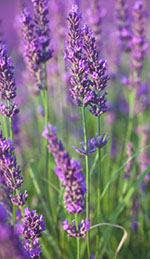 The daily demands and pressures of life can be quite distressing, in particular those demands that are work related. Work-related stress is a fact of life with which most individuals deal. Work-related stress not only negatively impacts work performance, but it can also adversely affect personal relationships as well. Stress from work can lead to fatigue, aching muscles, headaches, stomach problems, and emotional difficulties such as anxiety or depression. When you need to relieve work-related stress, you may want to consider using
The daily demands and pressures of life can be quite distressing, in particular those demands that are work related. Work-related stress is a fact of life with which most individuals deal. Work-related stress not only negatively impacts work performance, but it can also adversely affect personal relationships as well. Stress from work can lead to fatigue, aching muscles, headaches, stomach problems, and emotional difficulties such as anxiety or depression. When you need to relieve work-related stress, you may want to consider using 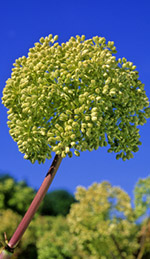 Humankind’s connection with nature is well documented through the centuries. Plants and trees have played a vital role in human mental and physical wellness, and they continue to present new avenues for general well-being and emotional stability.
Humankind’s connection with nature is well documented through the centuries. Plants and trees have played a vital role in human mental and physical wellness, and they continue to present new avenues for general well-being and emotional stability. 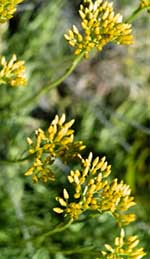 The phrase “what’s old is new again” certainly fits as a description for what the Greeks called “Gold of the Sun.” Helichrysum, from the flowers of the species Helichrysum angustifolium and Helichrysum italicum, has been used for centuries to create an oil that has cicatrisant properties to reduce scar tissue [1]. The chemical constituents in helichrysum oil, including linalool, limonene, a-pinene, geraniol, camphene, nerol, 1,8-cineole, terpinen-4-ol, neryl acetate, vitalidone, and eugenol, also have the ability to treat arthritis, respiratory conditions such as sinus infections and coughing, and may enhance tissue regeneration [1].
The phrase “what’s old is new again” certainly fits as a description for what the Greeks called “Gold of the Sun.” Helichrysum, from the flowers of the species Helichrysum angustifolium and Helichrysum italicum, has been used for centuries to create an oil that has cicatrisant properties to reduce scar tissue [1]. The chemical constituents in helichrysum oil, including linalool, limonene, a-pinene, geraniol, camphene, nerol, 1,8-cineole, terpinen-4-ol, neryl acetate, vitalidone, and eugenol, also have the ability to treat arthritis, respiratory conditions such as sinus infections and coughing, and may enhance tissue regeneration [1].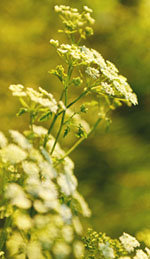 Carrots have been around the Middle East and throughout Europe for centuries. The Greeks and the Romans were well aware of the medicinal properties of
Carrots have been around the Middle East and throughout Europe for centuries. The Greeks and the Romans were well aware of the medicinal properties of 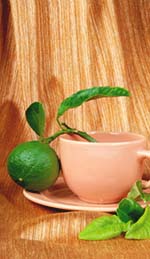 Some experts say that the bergamot tree is native to Southeast Asia and it was introduced to Europe years later, but others say its ancestral home was Greece. Regardless of its origin, the strange cross between a lime and orange tree (although some say orange and grapefruit tree) has made the Calabria region of Italy famous.
Some experts say that the bergamot tree is native to Southeast Asia and it was introduced to Europe years later, but others say its ancestral home was Greece. Regardless of its origin, the strange cross between a lime and orange tree (although some say orange and grapefruit tree) has made the Calabria region of Italy famous.
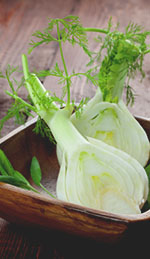 The Romans called fennel the “herb of sight,” and recent studies show that fennel does have potential in treating glaucoma. In India and Pakistan, fennel flavors spicy dishes, and is chewed as an after-meal breath freshener. China combines it with other spices, and the Lebanese use it along with onions and flour in a special omelet recipe called ijjeh. The Germans and Italians mix fennel with avocado and chicory in salads, and it’s even an ingredient in toothpaste. The oil has a sweet-spicy scent similar to
The Romans called fennel the “herb of sight,” and recent studies show that fennel does have potential in treating glaucoma. In India and Pakistan, fennel flavors spicy dishes, and is chewed as an after-meal breath freshener. China combines it with other spices, and the Lebanese use it along with onions and flour in a special omelet recipe called ijjeh. The Germans and Italians mix fennel with avocado and chicory in salads, and it’s even an ingredient in toothpaste. The oil has a sweet-spicy scent similar to  The allspice tree is one of those finicky members of the plant family that only grows in certain areas of the world. Jamaica is well known for allspice tree growth, so much that at one time it was believed that allspice trees grew only on Jamaica! But some South American countries including southern Mexico, the greater Antilles, and areas of central America have also been successful in growing and harvesting allspice berries. Different types of
The allspice tree is one of those finicky members of the plant family that only grows in certain areas of the world. Jamaica is well known for allspice tree growth, so much that at one time it was believed that allspice trees grew only on Jamaica! But some South American countries including southern Mexico, the greater Antilles, and areas of central America have also been successful in growing and harvesting allspice berries. Different types of